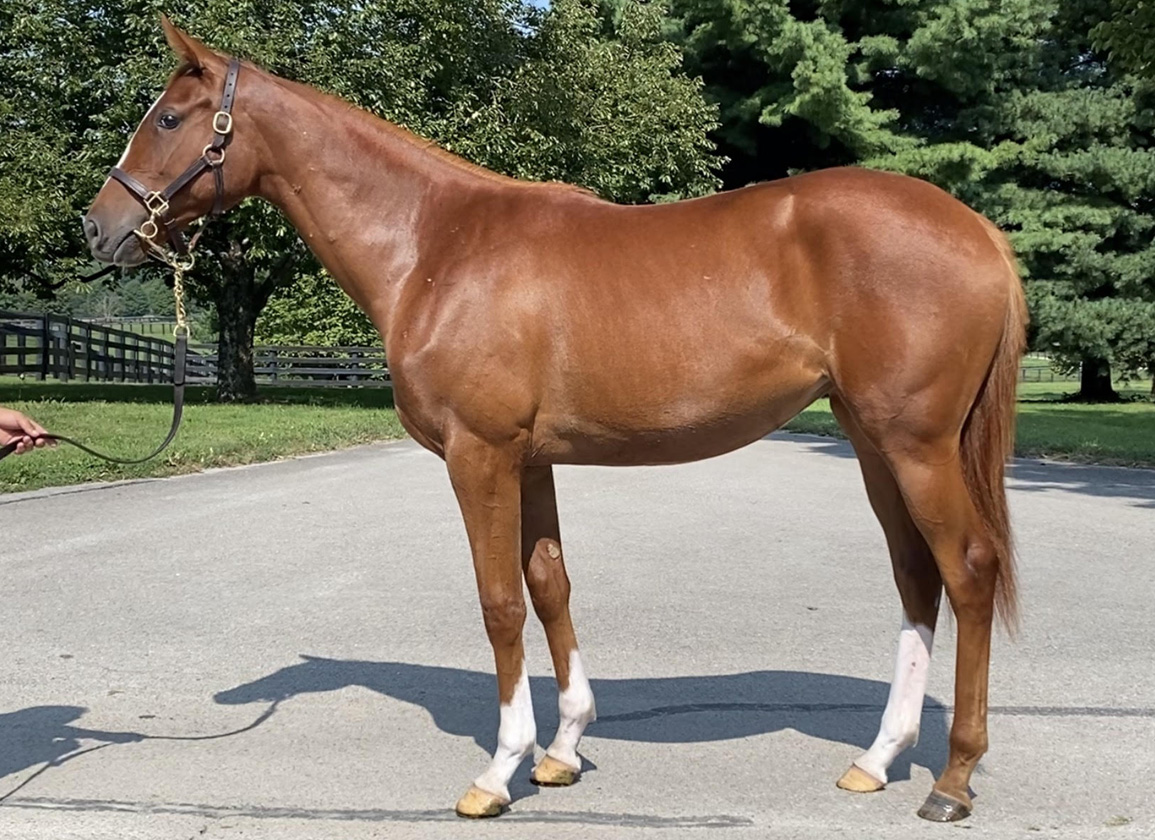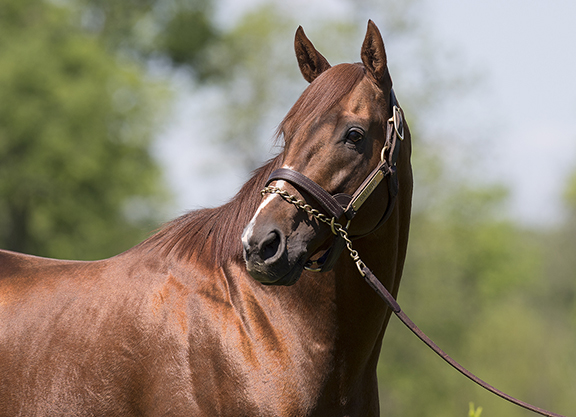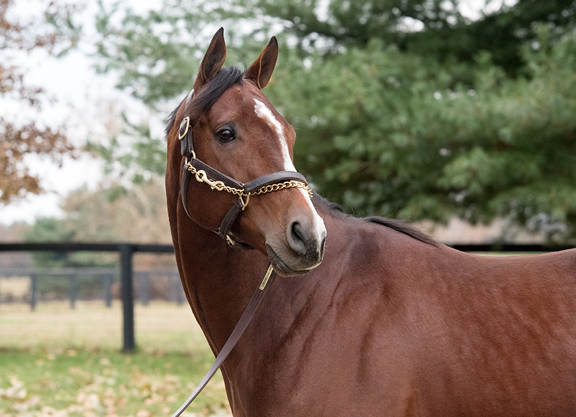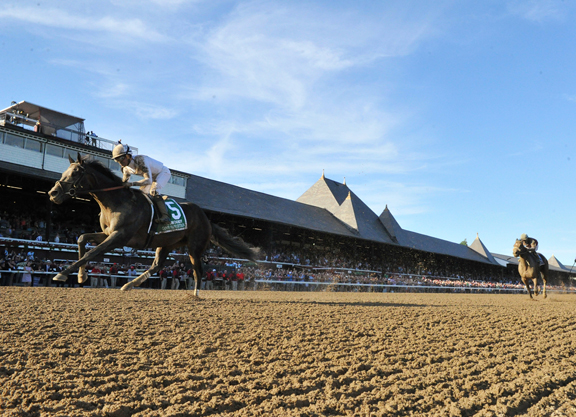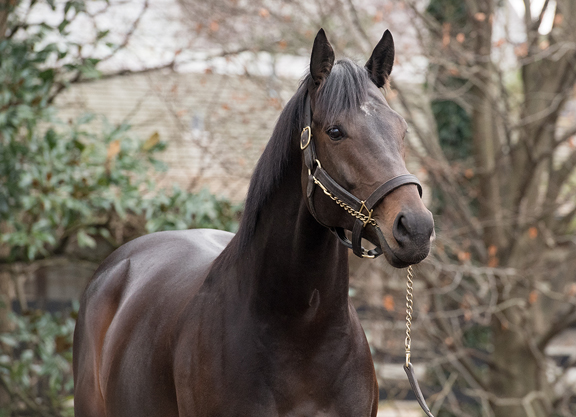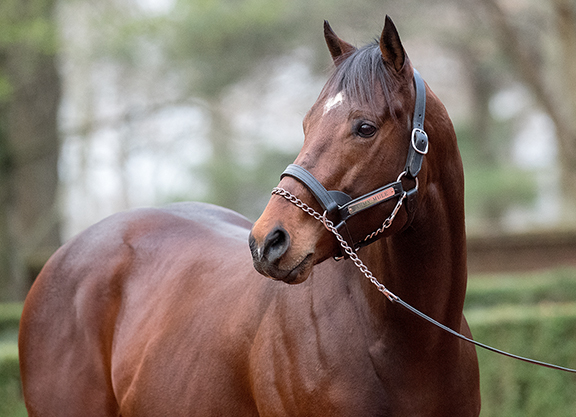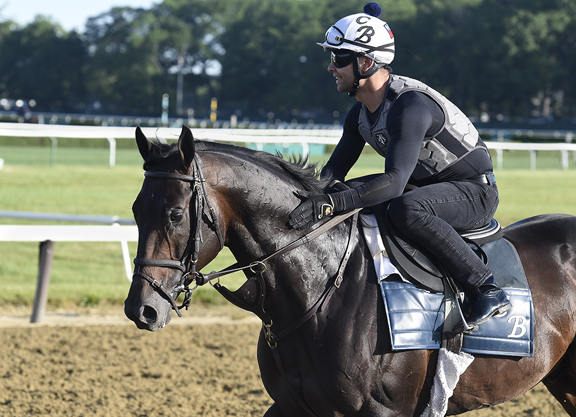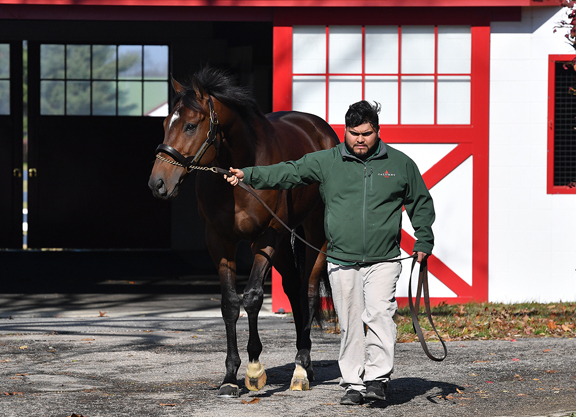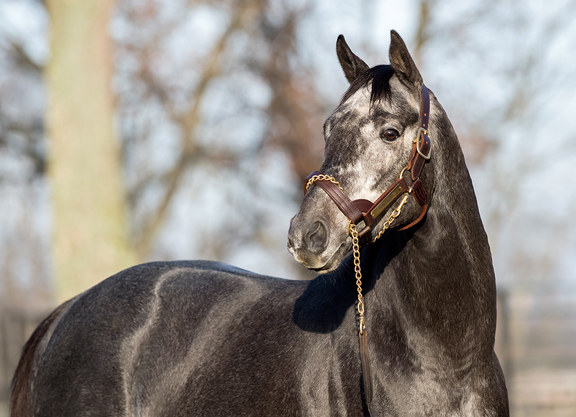For a farm so steeped in heritage, and so properly respectful of it, there's no mistaking the vitality, the aversion to complacency, animating Mill Ridge with a sixth generation now at the reins.
Back in April the Bell family grieved farm founder Alice Headley Chandler, a revered matriarch not just around their own hearth but among the whole Bluegrass community. But their loss, while poignantly refreshing their gratitude and sense of privilege, could only reinforce an engrained determination that her legacy be honored by all the ambition that had characterised her own, pioneering tenure.
Her son Headley Bell, managing partner since 2008, had already promoted her grandson Price as general manager in August 2020. The previous year, meanwhile, they had welcomed Oscar Performance to revive a stallion station that had gathered dust since Gone West and Diesis gave it such international significance. And now, in a confident invitation to traffic from the impending breeding stock sales, they have just extended capacity with the acquisition–or retrieval, rather–of 288 acres from Calumet.
Retrieval, because this parcel of land was once part of the Beaumont Farm where Mrs. Chandler's father Hal Price Headley raised the likes of Menow and Alcibiades. On his death, in 1962, she inherited just a nook of the farm, around 1/16th of its extent; while this portion was left to her sister. Later on, it was actually leased by Mill Ridge for a few decades until the farm shared in the shocks absorbed by the industry after 2008, and it was sold to Calumet in 2015. Its return to the fold, then, is expressive of a striving for regeneration by the heirs to the breeder of the game-changing Sir Ivor.
“It's the type of land we all covet,” says Price. “Big, open spaces for horses to develop, 40-acre pastures with big slopes and big trees. But this is also about our team, our human capital. Our infrastructure was developed to handle 130, 140 mares. As our numbers declined with the foal crop, we didn't adjust our team. So we have talented people, blessed by incredible horsemanship and experience. To utilize that to the full, we need more volume; and to accommodate that, we needed more land. So that's how we hope to make this thing go. We're lucky to have people who are so passionate about the horse, and about the farm. Now we just need to make sure they have the stock to do what they do so well.”
This kind of calculation is as educated as you could find in our community, Price having returned to Mill Ridge not only bearing the laurels of an MBA from Vanderbilt's Owen School, but having already cut his teeth in the wider business world. Straight out of college–and it's easy to imagine his livewire interview–he was appointed CEO of a $40 million commercial real estate asset in Charlotte, North Carolina.
“That was a very service-minded framework, which I really enjoyed and have carried with me since,” he says. “Charlotte was booming, but after things went well there the company decided to move me to Nashville–at a time when there were then less than 1,000 people living downtown. Still in my mid-20s, I found myself with nearly half a million square feet of 30-year-old office space with a significant leasing problem.”
The point of this recollection, however, is not that the precocious salesman filled the vacant premises–though he duly did. What really told in Nashville was learning the organic connection between the commercial interests he happened to be serving, on the one hand, and improved viability for the city as a whole, on the other. Invited onto the board of a non-profit organisation devoted to downtown development, he embraced their agenda with a zeal that entitles him to a modest share of pride in Nashville's “meteoric” progress since.
That experience was not lost on Price after he accepted his father's offer to return to a world in which he had, naturally, been given a thorough grounding in his youth–initially by joining the Nicoma Bloodstock agency that can count Street Sense (Street Cry {Ire}), Barbaro (Dynaformer), Havre de Grace (Saint Liam) and Bricks and Mortar (Giant's Causeway) among counselled matings. In the 10 years since, Price and his father have been pivotal to the evolution of Horse Country, the open-our-gates tours that have transformed public engagement with Bluegrass farms. And Horse Country, of course, obeyed much the same principles that Price had seen validated in Nashville: namely, that businesses will always thrive if embracing and enhancing their social and cultural setting.
A few days ago, Mill Ridge hosted a six-term congressman from Georgia on a Horse Country tour. He was entranced, stuck around for a coffee, chatted. At one point he looked Price in the eye. “Don't you ever sell this place,” he said. The next day Price found himself driving another septuagenarian visitor round the farm: a woman from upstate Ohio who had been drawn to the sport by Zenyatta–not a fanbase, it must be granted, always received with patience by busy professionals.
“This woman had become our biggest 'virtual tour' fan,” Price explains, referring to the enterprising solution adopted when lockdown broadsided Horse Country. “As we drove around she kept stopping me to take in the view, kept saying, 'I just can't believe where I am right now…' It made me feel as close to John Lennon as I'm ever likely to feel! So here we had a woman who's been around the sun 75 times, speechless, within 24 hours of our visitor from Georgia. Two such different people, both entering our orbit for a very brief time–and it was interesting to me that not only did we have that impact on both of them, but they each had an impact on us, too.
“Because it's that kind of experience that reminds us how special this all is, how very lucky we are to do what we do–and the responsibility we all have, to share the horse, to share the land, to share Lexington. At the end of the day, this business is about humans and horses. And that is not something we can assign to associations, to NTRA or TOBA or the Jockey Club. It's the responsibility of all of us, as individuals.”
Happily, Price feels that horse evangelism is a little easier now than has previously been the case. Behind Mill Ridge's roll of the dice, in expanding capacity, is a conviction that the whole sport has a new spring in its step: that people are eager to go out and enjoy life, to put the economic and social trauma of the pandemic behind them.
“I feel there's a lot of good momentum,” he says. “In taking on this risk, this big investment, we feel there are great opportunities going forward for the industry, and for Mill Ridge as well. Finally it feels like we're rowing together a little more than we have been. We see great hope for our sport, for our community, and we're investing in ourselves and welcoming new clients. I guess it feels like the first time, really since the '08 crash, that everything is really growing again.
“Back then we all felt like we were battening hatches down, constantly baling out water: the foal crop adjustment, PETA, Santa Anita, aftercare. With no fan engagement, that could have knocked us out. Quite frankly, if we'd continued being complacent in our racetracks, our horses, our fans, we'd be shrivelling and wilting away. We still have some big issues, obviously. But the key tenets of what we do, and how we share those, have been restructured. And I'd say the foundation is now stronger than it has been in my lifetime. We're excited by that.”
Horse Country had an incidental benefit, too. With such a delicate margin between family and professional life, Price and Headley treated the enterprise as a useful “test drive” for how they might work together in their own business.
“In working so closely on a passion project, on something that wasn't our core business, Dad and I could develop a confidence in each other that has ultimately allowed this transition to take place,” Price says. “We saw that we could work as team-mates, as opposed to me coming in and saying, 'This is how you should be doing everything,' or him looking at me saying, 'You haven't proven you can do anything.' Mill Ridge is here today, and successful, because of my dad and my grandmother, because of my uncles, and because of our clients. And Mill Ridge tomorrow will be successful for the same reason.”
At this point Headley joins the call. A man of such courtesy and dignity was never going to cling resentfully to the authority of a parent, and he discusses the situation with candour and quiet pride.
“We're fortunate that in Price, and the team he's building, we have a lot of talent,” he says. “He happens to be our son, but he's always been visionary, always been willing to take a position and back it up, always been a team player. When he was president of his class in high school, that wasn't because he was some super jock. It was because he was inclusive of others, and elevated those around him. And he brings in people with similar strengths. So not only is Mill Ridge better off, but the industry will be, too.”
Headley likes the way the transition evolved almost of its own volition. There was no turning point, no formal deadline. It gradually became clear, during lockdown, that the time was right; but that realization had been reached by lifelong increments. They fortified the arrangements by involving Price's mother, sister and wife; and there was so much counsel and support at hand: from “Doc” Chandler, from Headley's brothers, from Duncan Macdonald who worked here for 38 years.
“Remember, there had never been any pressure for me to go on with this, and nor was there any pressure on Price,” Headley says. “It did not have to go on. What I've done with Nicoma for 45 years has been very fulfilling. Mill Ridge, I'd long been part of the team parallel to Nicoma but stepped in only in '07, when Mom was 82.
“And out of that evolution, when Gatewood [Bell, nephew] was going out on his own, I approached Price and said: 'If you're interested, here's where we're are.' And do you know what he said? 'Let me get back to you, Dad.' He's going to get back to me! But about three months later, he did come back. And he said: 'Three things, Dad. Number one: I would never want to do anything to jeopardize our relationship.' So that was, like, wow. 'Number two: I'm bringing what I believe to be my future wife into this environment. Is that fair to her? And number three: am I qualified to do it?'”
But just to ask those questions, in effect, was to answer them. It's not just the equine graduates of this regime that you can judge by the results.
“I've been very fortunate through my time, to be successful enough to have the liquidity to navigate the water,” reflected Headley. “That's positioned us to build for the next generation, without, say, needing someone to come in and partner. There's nothing more enriching than being able to include your children in whatever you're doing, especially something like this. And that's something we feel every day, with these Horse Country tours. People say, first off: 'Thank you very much for sharing.' But then also: 'Wow, do you know how lucky you are to do what you do?!' So all we ever have to do is step out the door and look. We don't take anything for granted.”
That can seldom have been so true as when the family shared its memories of Headley's mother this spring.
“Really, she stays alive through this effort,” remarks Headley. “I say that to people often. We feel her presence here, in our efforts. Dr. Chandler has always been such a great team-mate. It's been difficult for him, of course, but he really embraces Price and his energy.”
Price, for his part, will always view his grandmother as a model of how to be a good citizen of the Turf. “Reflecting on her life, I think the great inspiration is that she didn't ever back down from any challenge,” he says. “Not just at the farm, but in the industry too. KTA, KTOB, Gluck Center, dozens of causes. She was a very thoughtful person and passionate too: when she had a conviction, she worked tirelessly with many like-minded people to make things better.”
And, with that inherited sense of the bigger picture, Price is adamant that connecting fans with the horse is not just good public relations, but good business.
“Our personal experience is that the magic we really need to push comes from bringing people to the farm, bringing them to the races, introducing people to horses,” he says. “That's not to diminish everything else that's being done: the TAA, the improved screenings and accountability at the racetrack. But that's where we felt we could contribute: connecting people to horses. There's great curiosity out there as to how you breed a horse, raise a horse, choose a horse to get to the finish line first. That's the elixir we have, and I guess sharing that with more people has always inspired me.”
Of course, you can only engage people with horses if you know how to engage with people. And that's what really augurs so well for the new era at Mill Ridge–though that MBA presumably won't do any harm, either.
“In the end I guess I'm curious by nature,” Price says. “Maybe that additional schooling gave me the confidence to be inquisitive, and to learn from the type of people who are now our customers. But more importantly it also gave me even greater confidence that what we have is very special; and that we're very lucky. It's just that sometimes we don't recognize that, or don't package it quite right.”
Its pastures new contain an apt analogy for what is happening at Mill Ridge. Because if the horse-lore handed down between generations represents deep soil, dense roots, then you don't just leave turf to grow rank or parched. It's by keeping active, by mowing or grazing, that you foster its healthy renewal.
“While we're in transition, the industry is also in transition,” notes Headley. “You see it on the racetrack, you see it in these partnerships, you see it with NYRA. There's an evolution. All you had to do is look at Keeneland recently, when Gatewood filled up the winner's circle with family and friends, maybe 60 strong–and probably 30 of them under the age of eight! It's certainly not just Price, there's a lot of talent in his generation. So this feels very natural, fitting well with what's happening in the industry as a whole. This is a really exciting time.”
The post Pastures New Maintain Old Standards at Mill Ridge appeared first on TDN | Thoroughbred Daily News | Horse Racing News, Results and Video | Thoroughbred Breeding and Auctions.

